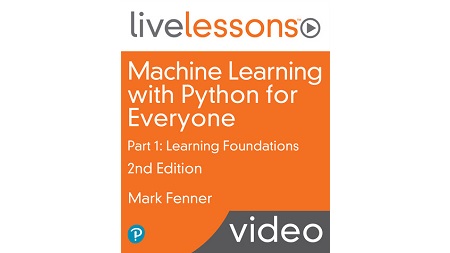
English | MP4 | AVC 1280×720 | AAC 44KHz 2ch | 47 Lessons (5h 54m) | 1.61 GB
Machine Learning with Python for Everyone LiveLessons Part 1: Learning Foundations, 2nd Edition
Code-along sessions move you from introductory machine learning concepts to concrete code.
Machine learning is moving from futuristic AI projects to data analysis on your desk. You need to go beyond nodding along in discussion to coding machine learning tasks. In Machine Learning with Python for Everyone Part 1: Learning Foundations, Second Edition, the videos skew away from heavy mathematics and focus on showing you how to turn introductory machine learning concepts into concrete code using Python, scikit-learn, and friends. Our focus is on stories, graphics, and code that build your understanding of machine learning; we minimize pure mathematics.
You learn how to load and explore simple datasets; build, train, and perform basic learning evaluation for a few models; compare the resource usage of different models in code snippets and scripts; and briefly explore some of the software and mathematics behind these techniques.
Learn How To
- Build and apply simple classification and regression models
- Evaluate learning performance with train-test splits
- Evaluate learning performance with metrics tailored to classification and regression
- Evaluate the resource usage of your learning models
Who Should Take This Course
If you are becoming familiar with the basic concepts of machine learning and you want an experienced hand to help you turn those concepts into running code, this course is for you. If you have some coding knowledge but want to see how Python can drive basic machine learning models and practice, this course is for you.
Course Requirements
A basic understanding of programming in Python (variables, basic control flow, simple scripts)
Lesson 1: Software Background
In Lesson 1, Mark discusses the environment used to run the code and several of the fundamental software packages used throughout the lessons. Mark discusses scikit-learn, seaborn, and pandas–high-level packages that have many powerful features. Mark also introduces numpy and matplotlib–more foundational packages.
Lesson 2: Mathematical Background
In Lesson 2, Mark continues the discussion of background and foundations. He covers several important mathematical ideas: probability, linear combinations, and geometry. He approaches these concepts from a practical and computational viewpoint. He introduces them but shies away from theory. He also spends a few minutes talking about technical issues that affect how you approach mathematics on the computer.
Lesson 3: Beginning Classification (Part I)
In Lesson 3, Mark gets your attention squarely focused on building, training, and evaluating simple classification models. He starts by introducing you to a practice dataset. Along the way, he covers train-test splits, accuracy, and two models: k-nearest neighbors and naive Bayes.
Lesson 4: Beginning Classification (Part II)
In Lesson 4, Mark continues the discussion of classification and focuses on two ways to evaluate classifiers. He shows you how to evaluate learning performance with accuracy and how to evaluate resource utilization for memory and time. Mark shows you how to do this both within Jupyter notebooks and also in standalone Python scripts.
Lesson 5: Beginning Regression (Part I)
In Lesson 5, Mark discusses and demonstrates building, training, and basic evaluation of simple regression models. He starts with a practice dataset. Along the way, he discusses different ways of measuring the center of numerical data, and then he discusses two models: k-nearest neighbors and linear regression.
Lesson 6: Beginning Regression (Part II)
Lesson 6 continues regression. Mark explains how we can pick good models from a basket of possible models. Then, he covers how to evaluate learning and resource consumption of regressors in notebook and standalone scenarios.
Table of Contents
Introduction
1 Machine Learning with Python for Everyone: Introduction
Lesson 1: Software Background
2 Topics
3 1.1 What Is Machine Learning?
4 1.2 Building Learning Systems
5 1.3 Environment Installation
6 1.4 Three Things You Can do with NumPy and matplotlib
7 1.5 Three Things You Can do with Pandas
8 1.6 Three Things You Can do with scikit-learn and Friends
9 1.7 Getting Help
Lesson 2: Mathematical Background
10 Topics
11 2.1 Probability
12 2.2 Distributions
13 2.3 Linear Combinations
14 2.4 Geometry, Part 1
15 2.5 Geometry, Part 2
16 2.6 Geometry, Part 3
17 2.7 When Computers and Math Meet
Lesson 3: Beginning Classification (Part I)
18 Topics
19 3.1 Setup and the Iris Dataset
20 3.2 Classification, Accuracy, and Splitting
21 3.3 Accuracy
22 3.4 Introduction to Nearest Neighbors and Naive Bayes
23 3.5 k-Nearest Neighbors
24 3.6 Train-Test Split and Nearest Neighbors (Part 1)
25 3.7 Train-Test Split and Nearest Neighbors (Part 2)
26 3.8 Naive Bayes
Lesson 4: Beginning Classification (Part II)
27 Topics
28 4.1 Learning Evaluation, Part 1
29 4.2 Learning Evaluation, Part 2
30 4.3 Resource Evaluation: Time
31 4.4 Resource Evaluation: Memory
32 4.5 Scripts
Lesson 5: Beginning Regression (Part I)
33 Topics
34 5.1 Setup and the Diabetes Dataset
35 5.2 Introducing Regression
36 5.3 Measures of Center
37 5.4 k-Nearest Neighbors for Regression
38 5.5 Introducing Linear Regression and NN Regression
39 5.6 Linear Regression, Part 1
40 5.7 Linear Regression, Part 2
Lesson 6: Beginning Regression (Part II)
41 Topics
42 6.1 Optimization, Part 1
43 6.2 Optimization, Part 2
44 6.3 Optimization, Part 3
45 6.4 Learning Performance
46 6.5 Resource Evaluation
Summary
47 Machine Learning with Python for Everyone: Summary
Resolve the captcha to access the links!